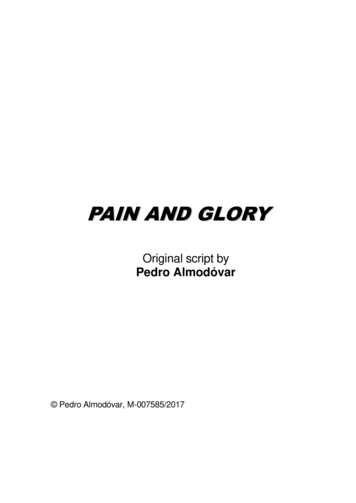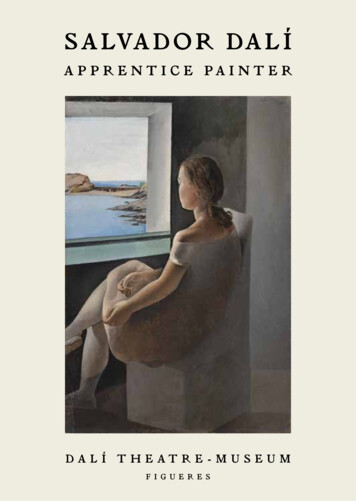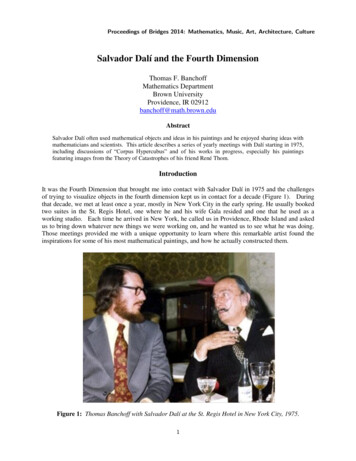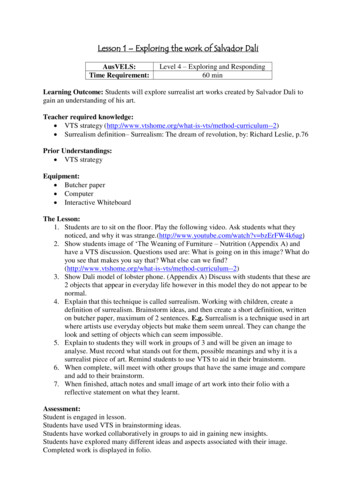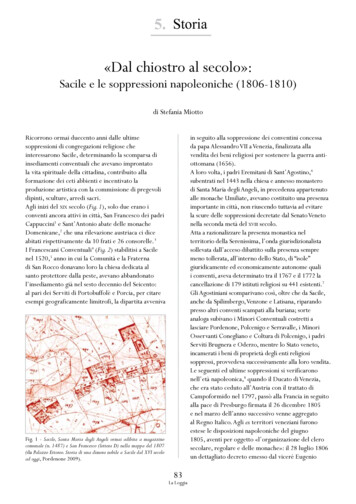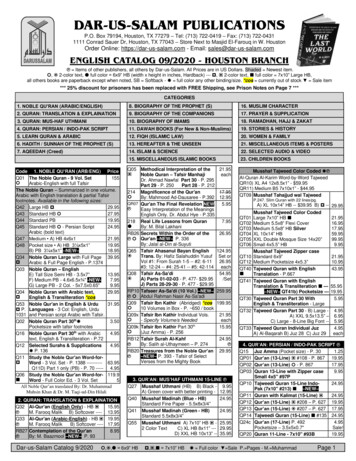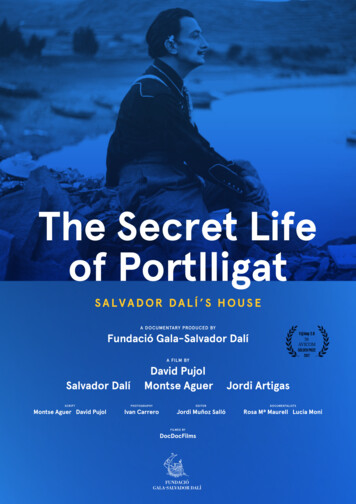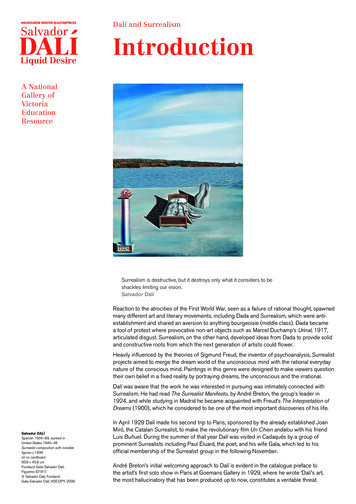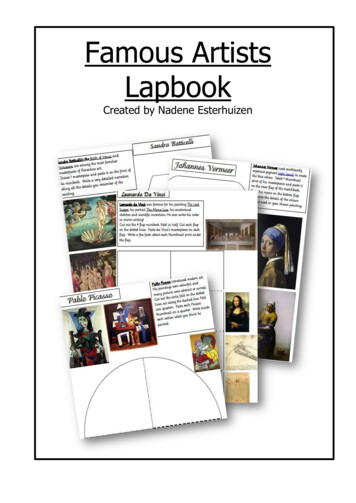
Transcription
Salvador Dalí:BIOGRAPHYIntroductionAt the age of 37, in 1941, Salvador Dalí finished writing his autobiography TheSecret Life of Salvador Dalí. The book, published the following year, revealed a web offactual and fictionalized events from the artist’s life. Dalí was by this time aninternational celebrity, a status he enjoyed as much for his art as for his eccentric publicimage. In the years since, countless biographies have been written, unraveling themystery Dalí created, telling of the man who became the legend: Salvador Dalí.Childhood and FamilySalvador Dalí began his life May 11, 1904, the second-born son of Salvador DalíCusí and Felipa Domènech Ferrés. Sadly, he never knew his older brother, also namedSalvador Dalí, who died in infancy only nine months earlier. In 1908 came the birth ofhis only sister, Ana María. The family lived in the Catalan town of Figueres, Spain, butspent the summers in the seaside village of Cadaqués. Dalí’s father was a notary, aposition of political and social power. As a child Dalí feared his father, who was knownfor his bad temper, and took refuge in the comfort and kindness of his mother and thehousehold servants who spoiled him.At the age of four, the young Dalí began his formal education at the EscuelaPública (public school) in Figueres. Dalí disliked school, and spent much of his timedaydreaming instead of studying. Displeased with Dalí’s progress, his father transferredhim to a private school where all of his classes were taught in French. Though Dalíspoke Catalan at home and was also learning Spanish, French was to become thelanguage that he used as an artist. Dalí continued to dislike going to school because hehated the feeling of being confined to the classroom. During the school year he wouldlong for the summer months his family spent together in the seaside town of Cadaqués.He enjoyed the freedom of his childhood summers when he could make paintings anddrawings of his family and the picturesque coastline. At Cadaqués, Dalí studiedpainting with a family friend, Ramón Pichot, an artist who painted mostly in the style ofthe Impressionists, but also experimented with some styles of the Catalan avant-garde.Pichot, who lived in Paris and was friends with other artists including Pablo Picasso,was a mentor to Dalí throughout his youth, and was eventually successful in persuading
Dalí’s reluctant father to allow his son to apply for admission at the San FernandoAcademy of Art in Madrid.Student Years and the Catalan Avant-GardeIn 1922 Dalí gained admission to the Academy. He enjoyed the freedom of selfexpression he felt in Madrid, and developed close relationships with several of his fellowstudents including Federico García Lorca and Luis Buñuel (two artists he would latercollaborate with). Dalí experimented with several avant-garde painting styles, primarilyCubism, Futurism and Purism, which he learned about through reproductions in artjournals. He began showing his work in galleries in Barcelona and Madrid and had twosolo exhibitions, as well as showing his work in several other exhibitions with otherCatalan modernists. Though he was experiencing success in the Spanish art world, Dalífelt unchallenged by his instructors at the Academy. His tendency to challenge theauthority of the Academy and to encourage his peers to do the same, led to disciplinaryactions and eventually to his dismissal in 1926. Following his dismissal, Dalí returned toFigueres and devoted himself to painting. He continued to exhibit with the Catalanavant-garde, but his works displayed an increasingly disturbing imagery of mutilation anddecay. Even the Catalan art community became more and more horrified by his graphicdepictions, and as a result galleries in Madrid and Barcelona began to exclude Dalí fromexhibitions.Dalí and the SurrealistsIn 1929, Dalí partnered with his friend, Luis Buñuel, to create a short avant-gardefilm titled Un Chien andalou (An Andalusian Dog) consisting of a series of short scenesof unexplained violence and rotting corpses. The widespread acclaim for the film amongthe European avant-garde elevated the two to international fame and brought Dali toParis. In particular, the Surrealists took notice of Dalí and Buñuel, welcoming them totheir artistic circle. As a member of the Surrealist movement, Dalí was surrounded byartists who accepted his outlandish behavior, and celebrated the bizarre imagery in hisart. Besides meeting artists such as René Magritte and Hans Arp, Dalí also madeacquaintance with Gala, the wife of the Surrealist writer Paul Eluard. Even though shewas nine years his senior and already married, Dalí and Gala quickly becameinseparable, and moved to Paris together in the autumn of 1929. Five years later thecouple married in a civil ceremony. Gala, who was born in Russia as Elena Dmitrievna
Diakona, became Dalí’s muse but also served as his manager. Gala encouraged and attimes even drove Dalí in his pursuit of fame and fortune.Though Dalí was a member of the Surrealist movement, his affiliation was morethe result of shared interests than any genuine unity with the group. Like the Surrealists,Dalí found artistic inspiration in Sigmund Freud’s psychoanalytic studies, however hedid not embrace the communist social and political ideals of the movement, preferring tobe apolitical. Many of Freud’s publications began to appear in Spanish translations inthe 1920s, and Dalí read them voraciously. He became increasingly obsessed withpsychoanalysis and paranoia, and sought ways to include these concepts in his art,leading to his development of the ‘paranoic-critical method’ and his introduction ofSurrealist objects.Dalí’s relationship with members of the Surrealist movement, particularly with thegroup’s leader and founder, André Breton, was strained throughout the 1930s. His selfpromoting behavior and unwillingness to conform his own activities and attitudes to theSurrealist agenda created increasing disruption within the group. Though he continuedto participate in Surrealist exhibitions and attracted a great deal of attention to themovement, Breton became more openly critical of Dalí’s growing celebrity andcommercialism, dubbing him with the anagrammatic nickname ‘Avida Dollars.’ By 1939the rupture was absolute and Dalí broke from the Surrealists. Dalí’s departure from theSurrealists marked the end of his affiliation with artistic groups and movements.Through the rest of his life he remained independent as an artist, working in his ownstyle and exploring his own introspective and paranoic avenues.Dalí in AmericaThe 1940s brought about many changes in Dalí’s life and art. The civil war thathad devastated Spain in the late 1930s was over, but a new war was on the horizon. Asthe Nazis prepared to invade France, Dalí and Gala fled to the United States in selfimposed exile, as did many other artists during the Second World War. Dalí was wellknown by the American public, and very popular with American collectors as well.During the course of the decade Dalí’s works were exhibited in important galleries inNew York and in major exhibitions at the Museum of Modern Art in New York and thePhiladelphia Museum of Art. He also lent his talent to other media, collaborating withAlfred Hitchcock and Walt Disney on film and animation projects.
The dropping of atomic bombs on Hiroshima and Nagasaki in 1945 marked theend of World War II, and the beginning of a new period of artistic exploration for Dalí.He became fascinated with the power of the atom and the advances of modern science,particularly physics, and he sought ways to incorporate these elements into his art. Atthis same time, Dali’s artistic style also became more focused and deliberate in itsborrowing from the classical style of the Italian Renaissance. His renewed classicismand new scientific interests were accompanied by growing spirituality and dedication tothe Catholic Church. Dalí began painting in a style he described as ‘NuclearMysticism,’ combining mystical and scientific iconography to express what Dalí saw asa unity between the two that was proof of a divine power.Dalí’s Later YearsIn the final decades of his life, Dalí painted less and less. He remained aninternational celebrity, with major exhibitions of his works in cities around the worldincluding Tokyo, London, Paris, Ferrara (Italy) and Moscow. Before his death onJanuary 23, 1989, Dalí even witnessed the inauguration of two museums dedicated toexhibiting his art, The Salvador Dalí Museum in Cleveland, Ohio (now in St. Petersburg,Florida) and his own Teatre-Museu in Figureres, where he is buried.
Salvador Dalí: CHRONOLOGY(1904-1989)1904Born May 11th at Figueres, Spain. He is named after his brotherwho died a year earlier at the age of two.1916Dalí’s father enrolls the young artist in evening classes at theMunicipal School of Drawing in Figueres.1919Participates in an exhibition of local artists at the Municipal Theaterat Figueres.1921Dalí’s mother dies. His father marries her sister the next year.1922Enters the San Fernando Academy of Art in Madrid.1923Dalí is expelled for one year from the San Fernando Academy forcriticizing his lecturers and causing dissent amongst the studentpopulation.1924Paints Pierrot and Guitar.1925First solo exhibition at the Dalmau Gallery in Barcelona, Spain.Paints Figure at a Window, which is exhibited the following year ina show of the Catalan avant-garde.Sketches Don Salvador and Ana María Dalí (Portrait of the Artist’sFather and Sister).1926Dalí visits Paris for the first time and meets Pablo Picasso.Dalí is permanently expelled from the San Fernando Academy forsubversive behavior.1928Paints The Wounded Bird.1929Dalí makes the film Un Chien Andalou with his friend Luis Buñuel.The two artists officially join the Surrealist movement.Dalí meets Gala and they begin their lifelong companionship inParis. Their relationship causes a rift between Dalí and his fatheras well as other members of Dalí’s family.Paints The Enigma of Desire: My Mother.
1930Dalí begins developing and exploring his paranoic-critical method.He purchases a fisherman’s cottage at Port Lligat near Cadaqués,which he inhabits for a part of each year for much of the remainderof his life.1931Dalí exhibits in the first Surrealist show in the United States.1934Surrealist leader André Breton criticizes Dalí for not following theprinciples of the Surrealist movement, and attempts to have himexpelled from the group.Dalí and Gala marry in a civil ceremony.1935Paints The Angelus of Gala.1936Paints Soft Construction with Boiled Beans: Premonition of CivilWar.The Spanish Civil War begins.1937Dalí creates fabric, clothing and accessory designs for fashiondesigner Elsa Schiaparelli.1938Visits Sigmund Freud in London.Creates the sculpture Mae West Lips Sofa and paints Apparition ofFace and Fruit Dish on a Beach.1939Dalí completely disassociates from the Surrealist movement.The Spanish Civil War ends.1940Dalí flees with Gala to the United States via Spain after France fallsto the Nazis in June. (He visits father in Spain for the first timesince their falling-out nearly ten years before). Dalí and Galaremain in the United States until 1948.1941Retrospective exhibition of Dalí and Joan Miró opens at theMuseum of Modern Art in New York.Completes writing The Secret Life of Salvador Dalí, a partiallyfictionalized autobiographical account of his life that is publishedthe following year.
1945The dropping of the first atomic bomb on Hiroshima marks thebeginning of Dalí’s period of “nuclear mysticism.”Paints My Wife, Naked, Looking at her own Body, which isTransformed into Steps, Three Vertebrae of a Column, Sky andArchitecture.Assists Alfred Hitchcock on the set for the movie Spellbound.1949Visits the Pope and presents a version of his painting Madonna ofPort Lligat.1950Dalí’s father dies.1952Begins painting The Disintegration of the Persistence of Memory.1958Dalí and Gala marry in a religious ceremony in Spain.1963Paints Portrait of My Dead Brother.1964First major solo retrospective for Dalí in the Seibu Museum inTokyo.1971Inauguration of the Dalí Museum in Cleveland, founded byReynolds Morse, a major Dalí collector. In 1982 the collection ismoved to its current location in Saint Petersburg, Florida.1974Inauguration of the Teatre-Museu Dalí in Figueres.1978Elected to Académie des Beaux-Arts, Paris.1980Dalí spends much of the year at his home in Port Lligat recoveringfrom an illness.1982Gala dies on June 10th. Dalí has her buried in a crypt at their homeat Púbol castle in Spain.1983Paints his last picture, The Swallow’s Tail, from the Series onCatastrophe.1984Dalí is severely burnt in a fire in Púbol castle. He moves to theTorre Galatea, an annex of the Teatre-Museu Dalí, where heresides until his death.1989Dalí dies on January 23rd of heart failure and is buried in the cryptof the Teatre-Museu Dalí. His will bequeathes his property andremaining works, not previously donated to the Teatre-Museu Dalí,to the Spanish State.
Salvador Dalí: CURRICULUM CONNECTIONSART ACTIVITIES:Automatic Technique CollagesSuggested Images: Pierrot and GuitarThe Wounded BirdMaterials:Art paper suitable for glue and paint, pencils or oil pastels, glue, collagematerials (such as sand and found objects) and paint (optional).Automatic technique was a method used by many Surrealists for writing or creatingworks of art. The automatic process is guided by the unconscious, a technique whichcontrasts sharply with the more controlled and refined traditional artistic methods.Activity Description: To begin, select a pencil or pastel crayon and draw a variety oflines over the paper. Encourage the students to allow their pencils to move freely overthe page without trying to control the image. Now stop drawing and look at the formscreated on the paper. Select some of the forms that are more prominent or interesting toyou. Using paint, pencils and collage materials add definition to the forms to create aunified composition.‘Paranoic-Critical’ and Double Image DrawingSuggested Images: My Wife, Nude, Contemplating Her own Flesh Becoming Stairs,Three Vertebrae of a Column, Sky and ArchitectureThe Angelus of GalaSoft Construction with Boiled Beans: Premonition of Civil WarApparition of a Face and Fruit Dish on a BeachMae West Lips SofaMaterials:Drawing paper, pencils and a collection of images everyday objects (suchas chairs, clocks, cars, scissors, etc.).Dalí developed his ‘paranoic-critical method’ as a technique for visual representationintended to exploit delusional tendencies by creating images that can also suggestalternative realities and images to the unconscious mind. By the late 1930s Dalí hadevolved his technique as a way to create double images, pictures that can be readsimultaneously as two images.Activity Description: Select an an inanimate object. Study the features of the objectcarefully and imagine the object transformed into a face, or a human or animal body.Make a drawing that follows the form of the original, but also including the imaginedhuman or animal features.
InkblotsSuggested Images:Materials:The Angelus of GalaSoft Construction with Boiled Beans: Premonition of Civil WarApparition of a Face and Fruit Dish on a BeachMae West Lips SofaArt paper suitable for paint, nib pens and ink or very wet watercolor paint.Inkblots are unintentional images created when ink is dropped or splattered onto a pieceof paper. Often the inkblots remind people of familiar objects or images. At the time theSurrealists were active, psychoanalists used inkblots in order to gain a betterunderstanding of the unconscious of their patients by asking them to interpret the inkspills.Activity Description: Using droppers or nib pens, drop a small amount of ink onto thecenter of the paper. Tip the paper to assist the ink in moving over the paper then foldthe paper in half. Unfold the paper and allow the ink to dry. What do you see? As aclass look at the inkblots that were created. Ask students to describe what they see inthe inkblots.Surrealist ObjectsSuggested Image:Materials:Mae West Lips SofaAssortment of found objects, glue and paint or Sharpie pens (optional).Surrealist artists created objects that described the irrational images of dreams. Theprocess through which many of these Surrealist objects were assembled was guided bythe unconscious, without consideration of the object’s final form.Activity Description: Look through an assortment of found objects to find one thatinspires you. It may be helpful to handle the objects while thinking about what thetextures, colors and shapes remind you. Then select several other objects at random,and experiment with assembling them in different ways. When you have achieved anarrangement you find appealing, glue the objects together. You may wish to embellishyour object by painting it or writing on the surface using a Sharpie pen.
Salvador Dalí: CURRICULUM CONNECTIONSWRITING ACTIVITIES:Exquisite Corpse Drawing and Writing Small Group ActivityMaterials:Unlined paper and pencils.The Surrealists were a group of artists and writers who often collaborated in their work.They invented games, such as the ‘Exquisite Corpse,’ in which each participantcontributes creatively to the outcome.Activity Description: To play ‘Exquisite Corpse,’ divide students into groups of four.Each group should use one piece of paper folded into four equal horizontal parts. Thefirst person should draw the head of the creature in the top section, extending thedrawing slightly (about half an inch) into the second section. The second player extendsthe lines from player one to draw a torso in the second section, the third player drawslegs, and the last player draws the feet. Each person should draw their section withoutshowing it to the other players. Before passing it on to the next player, fold the paper sothat all except a half-inch section of the drawing is covered. After the feet are drawnopen the paper to examine the results.NOTE: You can also play this game by writing a sentence or short paragraph. Followthe same rules as above, but instead of drawing, have each person write a short phraseor a few sentences, folding the paper so that only a few words are visible to the nextplayer. After the last person has finished writing, read the results.Dream Writing ActivitySuggested Images: Enigma of DesireSoft Construction with Boiled Beans: Premonition of Civil WarApparition of a Face and Fruit Dish on a BeachDisintegration of the Persistence of MemoryActivity Description: Display an image of one of Dalí’s paintings. Ask students to copythe following sentence beginning onto their paper: “I had the strangest dream lastnight ”. Instruct the students to imagine that the painting they are looking at is animage from a dream. Complete the sentence above and incorporate it into a paragraphdescribing their imagined dream scenario.
Salvador Dalí: CURRICULUM CONNECTIONSRESEARCH ACTIVITIES:Research Topic: Spain and CataloniaDalí and several other artists of the early 20th century, including Joan Miró and PabloPicasso, were originally from the Catalonia region of Spain. Learn more about thegeography, history and cultures of Spain and the region of Catalonia. Make a timeline ofhistorical events and a list of important people from Spain and Catalonia.Research Topic: Sigmund FreudDalí and the Surrealists proclaimed the psychologist Sigmund Freud as the father oftheir movement. His theories on the unconscious and the 1900 publication TheInterpretation of Dreams inspired their use of automatic technique and dream imagery.Learn more about Sigmund Freud, dream theory and psychoanalysis. How did Freudfeel about Dalí after the two met in 1938? What do psychology experts feel aboutFreud’s theories today?Research Topic: Atomic EnergyAfter atomic bombs were dropped on Hiroshima and Nagasaki in 1945 to end theSecond World War, Dalí became interested in atomic energy and the destructive powerof the atom. Learn about how atomic energy is created. What was the impact followingthe bombing of Hiroshima and Nagasaki?SPANISH LANGUAGE ACTIVITIES:¡Viva Dalí!Activity Description: Pretend you are a journalist or a friend of Salvador Dalí writing anepitaph or eulogy memorializing the artist. Be sure to mention important dates andevents in the life of Dalí and describe at least one of his works of art. Remember to writein Spanish!¿Qué tu veas?Activity Description: Display an image of one of Dalí’s paintings. Instruct students tomake a vocabulary list in Spanish of the objects, composition and other features theyobserve in the painting. Divide students into small groups or pairs and ask them to havea conversation in Spanish about the painting, being sure to use the words from their list.
Salvador Dalí: GLOSSARY OF TERMSanagramA word or phrase created by rearranging the letters in aword or phrase.anthropomorphicSomething with human form or characteristics.automatismA method of writing or creating works of art withoutconscious intention regarding the appearance of the endproduct.avant-gardeDescribes art or artists departing from accepted tradition toexplore techniques or concepts in an original way.classicismDescribes art that is made with the qualities of order, clarityand harmony associated with the art of ancient Greeceand Rome.collageA work of art created by assembling paper, fabric or othermaterials on a flat panel or canvas.CubismA 20th century art movement developed as way to explorerealities of three-dimensional form in painting andsculpture.DadaA 20th century artistic and literary movement based ondeliberate irrationality and a rejection of traditional artisticvalues.double imagesA compositional technique used by Dalí in which formsappear as multiple images simultaneously.enigmaSomething that is mysterious or difficult to understand.FuturismA 20th century Italian art movement concerned withrepresenting the dynamism of modern technology andsociety in art.Nuclear MysticismAn artistic style developed by Dalí express what he saw asa connection between religious mysticism and science(particularly physics), such that he believed science wasproof of God’s existence and God’s existence was proof ofthe powers of science.paranoic-critical methodA method of visual representation developed by Dalíthrough which he attempted to exploit delusionaltendencies by creating images that can also suggestalternative realities and images to the unconscious mind.
physicsThe science of matter and energy.PierrotA male character of French pantomime usually having awhitened face and loose white clothing.psychoanalysisA personality theory focusing on the impact of personalexperiences, particularly childhood experiences anddreams. Also, a method of treating a person’s mentalillness through therapy sessions during which the personspeaks openly about such experiences.PurismA 20th century art movement concerned with order, clarityand objectivity, inspired by modern mechanics.putrefacto(Spanish) Putrid; relating to decomposition of organicmatter. During their student years, Dalí, Lorca and Buñuelapplied this term to everything that was sentimental andconventional in bourgeois Spanish society.RealismA term used in a general sense to describe non-idealizedand objective representation.SurrealismA 20th century artistic and literary movement dedicated toexploring the creative power of the unconscious mind,particularly dream imagery.unconsciousA mental state not marked by conscious thought, sensationor feeling.
Salvador DalíPhiladelphia Museum of ArtFebruary 16 – May 15, 2005TEACHER RESOURCE MATERIALS: IMAGE PROGRAMThese fourteen images represent only a small sample of the wide range of worksby Salvador Dalí featured in the exhibition. These materials are intended for use in yourclassroom before, after or instead of visiting the exhibition.These materials wereprepared for use with grades 6 through 12. Therefore, you may need to adapt theinformation to the particular level of your students. Please note that some of the imagesincluded in this program contain nudity and/or violence and may not be appropriate forall ages and audiences.
Philippe Halsman1942PhotographPhillipe Halsman Estate,Howard Greenberg Gallery, New York. 2004 Salvador Dalí, Gala-Salvador Dalí Foundation/Artists Rights Society (ARS),SALVADOR DALÍDiscussion Questions: Describe the way Dalí appears in the photograph. What do you think Dalí would say if he could speak?This portrait of Dalí was made when the artist was 38 years old. PhilippeHalsman, a friend of Dalí’s, photographed the image, capturing the artist’s face animatedby a maniacal expression. Since his days as an art student at the Academy in Madrid,Dalí had enjoyed dressing in an eccentric way to exhibit his individuality and artisticgenius. In this portrait Dalí’s mustache, styled in two symmetrical curving arcs,enhances the unsettling expressiveness of his face. Dalí often treated his longmustache as a work of art, sculpting the hairs into the curve of a rhinoceros horn orweaving dollar bills into it. Unlike many of Dalí’s other relationships, his friendship withHalsman was quite stable, spanning more than three decades. In 1954, Dalí andHalsman collaborated in the production of Dalí’s Mustache, a book of portraitphotographs of Dalí featuring the artist’s characteristic mustache, sculpted into odd andimaginative shapes, as though it were its own personality. The text of the book is adialogue of humorous interview-style questions about Dalí and his mustache, togetherwith the artist’s witty responses. For example: “Why do you wear a mustache? In orderto pass unobserved.”
1924Oil and collage22 x 20 in. (55 x 52 cm.)Madrid, Museo Thyssen-Bornemisza.Discussion Questions: Which parts of this work appear to be painted? Which parts are collaged?Is it difficult to tell? Which shapes stand out the most? Can you find places where these shapesare repeated? Why do you think an artist would borrow from another artist’s ideas? Is itcheating?The fragmented and abstract planes of Pierrot and Guitar show clearly Dalí’sinterest in Cubism in the early 1920s. As a young artist in Madrid, Dalí’s experimentswith European avant-garde styles were well in advance of his fellow students and evenmany of his instructors. Dalí learned about these movements by studying reproductionsof artwork in Modern art journals, including the Italian journal Valori Plastici. Pierrot andGuitar is heavily influenced by the Cubist collages of Pablo Picasso, both in the use ofthe collage technique and the subject matter of Pierrot and the guitar, images that areused frequently in Picasso’s works. It was not until two years after Dalí created thispainting, however, that he made his first trip to Paris and finally met Picasso. ThoughPierrot and Guitar is one of Dalí’s earliest works, it may be as close as he ever venturesinto painting abstract forms. Throughout his life Dalí maintains a preference forclassical form, figural imagery and scientific concerns and avoids art that might beconsidered sentimental or picturesque. 2004 Salvador Dalí, Gala-Salvador Dalí Foundation/Artists RightsSociety (ARS), New YorkPIERROT AND GUITAR
1925Pencil on paper20 x 11.8 in. (50 x 33 cm.)Madrid, Juan Abelló Collection. 2004 Salvador Dalí, Gala-Salvador Dalí Foundation/Artists Rights Society (ARS),New YorkDON SALVADOR AND ANA MARÍA DALÍ(PORTRAIT OF THE ARTIST’S FATHER AND SISTER)Discussion Questions: What adjectives would you use to describe the man in Dalí’s drawing? Whatadjectives could describe the woman? Why? Why do you think Dalí chose to show the faces of Don Salvador and AnaMaría in such detail, and not their bodies? Do you think the drawing isfinished?In his portrait of Don Salvador and Ana María, Dalí shows his father with a sternand impassive gaze. Though Dalí makes careful use of light and shadow to render thefaces of his father and sister, their figures are described by simple, outlined forms. WithDalí’s mastery, both techniques are successful in expressing the volume and solidnessof the figures. Look at the pendant watch hanging from the father’s vest, or the solidlythree-dimensional box of matches on the table. Notice how the lines of the father’sjacket have been drawn with one fluid motion. Despite its unfinished appearance, thissketch was among the works shown in Dalí’s first solo exhibition at the Dalmau Galleriesin Barcelona, Spain in 1925.Dalí had his first formal instruction in drawing at the age of twelve when his fatherenrolled him in evening classes at the Escuela Municipal de Dibujo (Municipal School ofDrawing). Dalí’s father encouraged the young artist by buying him supplies and artbooks, but was reluctant to allow his son to pursue a career as an artist because he didnot believe Dalí would be able to earn enough money from his paintings. Dalí’s
relationship with his father was often tumultuous. As a child Dalí felt intimidated by hisimposing and authoritative father; as an adult Dalí rarely spoke with his father following arift between the two over Dalí’s relationship with Gala, which began four years after thisdrawing was completed, while she was still married to another man, the Surrealist writerPaul Eluard.
1925Oil on canvas40 x 30 in. (103 x 75 cm.)Museo Nacional Centro de Arte Reina Sofia. 2004 Salvador Dalí, Gala-Salvador Dalí Foundation/Artists Rights Society (ARS),New YorkFIGURE AT A WINDOWDiscussion Questions: Where is the girl standing? What is she looking at? Why do you think Dalíhas positioned her so that we can only see her back? How would you describe the mood of this painting? How does the use ofcolor effect the overall mood? What visual relationships can you find between the girl, the curtains, thewindow and the landscape? What elements of the composition connect herto the room?During his years as a student at the San Fernando Academy of Arts in Madrid,Dalí experimented with several styles of the European avant-garde including Cubism,Futurism
Salvador Dalí: BIOGRAPHY Introduction At the age of 37, in 1941, . the European avant-garde elevated the two to international fame and brought Dali to Paris. In particular, the Surrealists took notice of Dalí and Buñuel, welcoming them to their artistic circle. As a member of the Surrealist movement, Dalí was surrounded byFile Size: 543KBPage Count: 31Explore furtherSalvador Dali: Biography, Paintings & Facts Study.comstudy.comSalvador Dali Biography - life, family, childhood, parents .www.notablebiographies.comSalvador Dali Biography - life, family, childhood, parents .www.notablebiographies.comSalvador Dali Biography - Facts, Childhood, Family Life .www.thefamouspeople.comSalvador Dalí Biography (1904-1989) - Life of Surrealist .totallyhistory.comRecommended to you b

